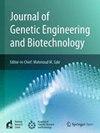Causal correlation between inflammatory cytokines and hypertrophic scar based on two-sample Mendelian randomization
IF 2.8
Q3 Biochemistry, Genetics and Molecular Biology
Journal of Genetic Engineering and Biotechnology
Pub Date : 2025-09-18
DOI:10.1016/j.jgeb.2025.100572
引用次数: 0
Abstract
Hypertrophic scars result from the abnormal proliferation of fibroblasts and the accumulation of collagen after skin injury. In this process, inflammatory cytokines act as crucial regulators. The large − scale release of inflammatory cytokines aberrantly activates fibroblasts. It promotes the proliferation of fibroblasts and the synthesis of collagen, and simultaneously inhibits collagen degradation. The purpose of this study is to investigate the causal correlation between inflammatory cytokines and hypertrophic scars (HS). This study applied a two-sample Mendelian randomization approach (TSMR), leveraging summarized data gathered by genome-wide association studies (GWAS). The inflammatory cytokines (8293 samples) and hypertrophic scar (HS, 207,482 samples) summary data were analyzed to figure out whether there was a causal connection of the two.The inverse variance-weighted (IVW) method was implemented to undertake causal analysis, also sensitivity, heterogeneity, and pleiotropy analyses were performed to further evaluate the results’ stability and dependability.Two inflammatory cytokines, IL-2 and CCL4, were identified as being associated with HS. The IVW analysis demonstrated a positive relationship between IL-2 and the risk of HS (OR = 1.51, 95 % CI = 1.06–2.15, P = 0.02), indicating that IL-2 is a risk factor for hypertrophic scarring, with elevated levels potentially promoting disease progression. In contrast, CCL4 was negatively associated with HS risk (OR = 0.86, 95 % CI = 0.74–0.99, P = 0.03), pointing to the fact CCL4 might function as a protective agent, where lower levels of CCL4 could inhibit scar formation. Sensitivity analyses verified the dependability of the TSMR results (P > 0.05). Our MR analysis indicates a causal correlation between inflammatory cytokines and hypertrophic scars. Specifically, IL-2 promotes hypertrophic scar formation, whereas CCL4 exerts a protective effect, reducing the risk of scar formation. These discoveries imply that inflammatory cytokines have a considerable part to play in the pathogenesis of hypertrophic scarring through modulating its formation.

基于双样本孟德尔随机化的炎症细胞因子与增生性瘢痕的因果关系
增生性瘢痕是皮肤损伤后成纤维细胞异常增殖和胶原蛋白积累的结果。在这个过程中,炎症细胞因子起着至关重要的调节作用。炎症细胞因子的大规模释放异常激活成纤维细胞。促进成纤维细胞的增殖和胶原蛋白的合成,同时抑制胶原蛋白的降解。本研究的目的是探讨炎症因子与肥厚性瘢痕(HS)之间的因果关系。本研究采用双样本孟德尔随机化方法(TSMR),利用全基因组关联研究(GWAS)收集的汇总数据。分析炎症因子(8293个样本)和增生性瘢痕(HS, 207482个样本)汇总数据,探讨两者之间是否存在因果关系。采用逆方差加权(IVW)法进行因果分析,并进行敏感性、异质性和多效性分析,进一步评价结果的稳定性和可靠性。两种炎症细胞因子IL-2和CCL4被确定与HS相关。IVW分析显示IL-2与HS风险呈正相关(OR = 1.51, 95% CI = 1.06-2.15, P = 0.02),表明IL-2是肥厚性瘢痕形成的一个危险因素,IL-2水平升高可能促进疾病进展。相比之下,CCL4与HS风险呈负相关(OR = 0.86, 95% CI = 0.74-0.99, P = 0.03),这表明CCL4可能作为一种保护剂,其中较低水平的CCL4可以抑制疤痕形成。敏感性分析验证了TSMR结果的可靠性(P > 0.05)。我们的磁共振分析表明炎症细胞因子和增生性疤痕之间存在因果关系。具体来说,IL-2促进增生性瘢痕形成,而CCL4发挥保护作用,降低瘢痕形成的风险。这些发现暗示炎症细胞因子通过调节增生性瘢痕的形成在其发病机制中起着相当大的作用。
本文章由计算机程序翻译,如有差异,请以英文原文为准。
求助全文
约1分钟内获得全文
求助全文
来源期刊

Journal of Genetic Engineering and Biotechnology
Biochemistry, Genetics and Molecular Biology-Biotechnology
CiteScore
5.70
自引率
5.70%
发文量
159
审稿时长
16 weeks
期刊介绍:
Journal of genetic engineering and biotechnology is devoted to rapid publication of full-length research papers that leads to significant contribution in advancing knowledge in genetic engineering and biotechnology and provide novel perspectives in this research area. JGEB includes all major themes related to genetic engineering and recombinant DNA. The area of interest of JGEB includes but not restricted to: •Plant genetics •Animal genetics •Bacterial enzymes •Agricultural Biotechnology, •Biochemistry, •Biophysics, •Bioinformatics, •Environmental Biotechnology, •Industrial Biotechnology, •Microbial biotechnology, •Medical Biotechnology, •Bioenergy, Biosafety, •Biosecurity, •Bioethics, •GMOS, •Genomic, •Proteomic JGEB accepts
 求助内容:
求助内容: 应助结果提醒方式:
应助结果提醒方式:


